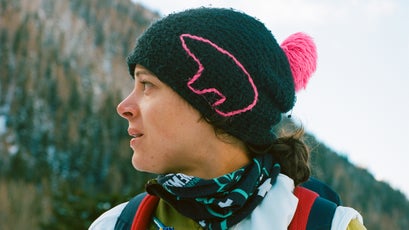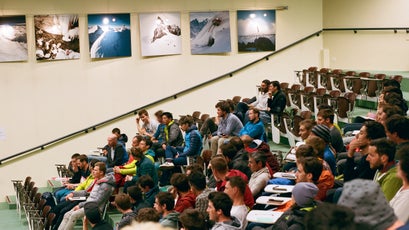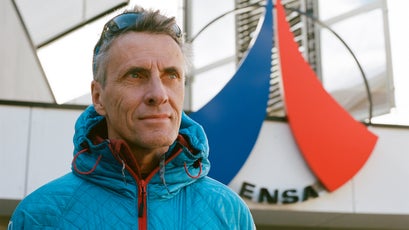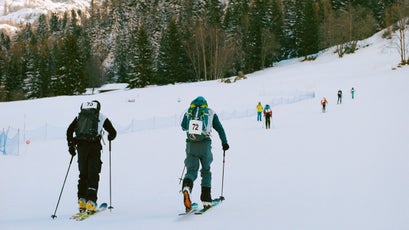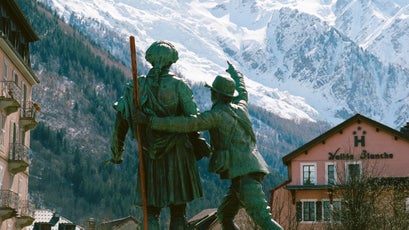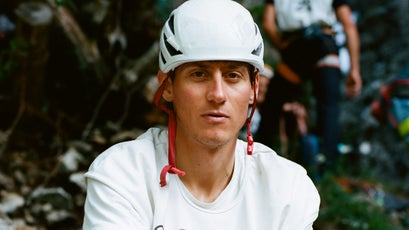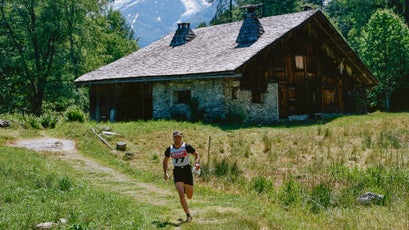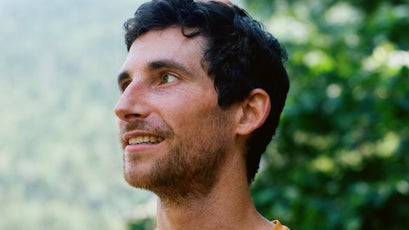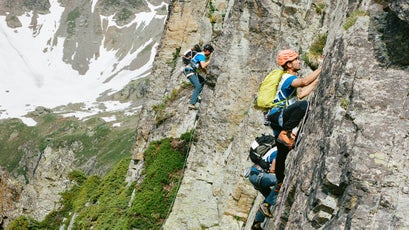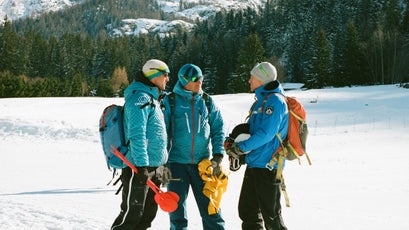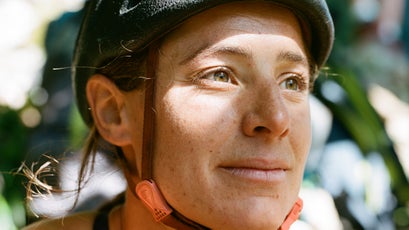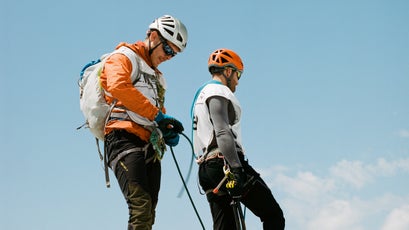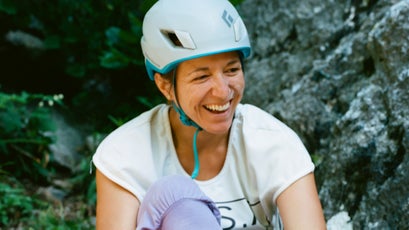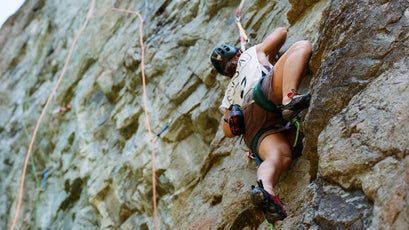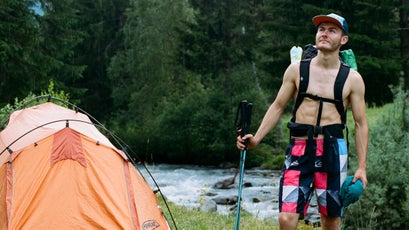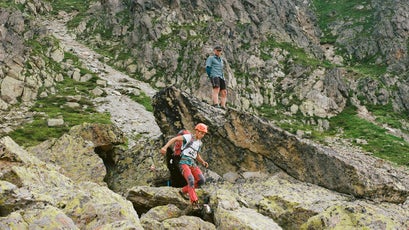You Won’t Pass Chamonix’s Mountain-Guiding Test
Le Probatoire is one of the toughest challenges in the outdoors, used for decades to pick alpine professionals in France's legendary hub of glacier skiing, climbing, and deadly terrain. Only the strongest make it, but Simon Akam wonders: Is selection by ordeal still the best way to groom competent guides?
New perk: Easily find new routes and hidden gems, upcoming running events, and more near you. Your weekly Local Running Newsletter has everything you need to lace up! .
For the closing test on ice day, the women went last.
The setting was a streaked, bulbous frozen face on the fractured lower section of the Glacier du Tour, the northernmost ice sheet in the French portion of the Mont Blanc massif. The Swiss border started at the flanking ridgeline, above the newly renovated Albert Premier Hut. The altitude was around 8,400 feet, a little lower than the peaks of the Aiguilles Rouge, mostly snow-free now in July. A line of anchors and cord ran some 50 feet up the ice.
The test was straightforward enough. Using two leashless axes, candidates would have to climb the 50 feet of vertical ice, then traverse horizontally for another 20 feet, then descend. Time limit: six minutes.
It was around noon, and below the east-facing ice wall the shadow was narrow; it covered some people belaying the climbers but little else. Farther back, in blue quilted jackets supplied by the Japanese apparel firm Onyone to the —France’s National School for Skiing and Mountaineering, ENSA for short—stood judges who would assess performance. Other instructors, including a doctor and a nurse, lolled on a higher ice crest in the sun.
Roughly 60 men had already been through this test. Now it was the turn of four women. Among them was Mélanie Martinot, the 32-year-old daughter of a ski instructor and ski patroller, who worked as the manager of the Refuge de l’Olan, a mountain hut at 7,690 feet in the Écrins Massif to the south.
Another was Valentine Fabre, a 42-year-old woman, originally from Paris, who had tried and failed to pass this test three times since 2015. “I’ve been twice to the World Cup for ski mountaineering,” said Fabre, a doctor who works for the French military. “But the only qualification that lets you teach ski mountaineering, if you want to take clients on glaciers, is to be a mountain guide.”
Hulya Vassail, 28, also worked in a mountain hut, though a much closer one: the Albert Premier, perched on the rocks above this very glacier. “It’s a project I’ve had for a long time,” she said, simply, of her desire to become a guide, a profession in which women are vastly outnumbered by men.
Finally there was Aurélia Lanoë, a 30-year-old who lived a “paradisiacal” nomadic existence in a converted ambulance as an accompagnatrice en moyenne montagne, a lower level of qualification than mountain guide, which meant she could take hikers out in summer and snowshoers in winter, but not use ropes or other technical alpine equipment with clients.
“It’s certain we’re in a minority,” she said of the female candidates. “But while the older generation of guides were different, with the new generation it’s rare to find machismo, and many are very open.”
“Physiologically, though,” she said of herself and the other women, “we are not the same.” Physical differences aside, the question for everybody here was this: Can I find the strength and skill to get through?
The École Nationale de Ski et d’AlpinÂisme’s entrance test, Le Probatoire, translates as “the probationary exam,” and the name correctly hints that mountain guiding in Europe is a different trade than in the United States, where guiding concessions are generally given by park authorities to companies who then train their own apprentices. U.S. guiding is becoming more regulated, but the system is still much less formal than in Europe.
The activities of European guides range from basic école de glace—ice school, taking groups for their first steps on glaciers in crampons—to leading people up some of the most famous (and difficult) terrain in the Alps, such as the north face of the Eiger. Much of guiding work concentrates on common bucket-list objectives—climbing Mont Blanc, or skiing the famous Vallée Blanche off-piste descent in Chamonix. But you can hire a guide for anything, and some also work on longer-term gigs with overseas expeditions. Rates in France run between $300 and $525 per guide per day.
The job has its origins in the early stages of alpinism, in the 19th century, when gentlemen climbers—often British—would engage local French, Italian, or Swiss farmers to take them to the peaks. Through the decades, the good and bad parts of seeking assistance in these mountains have persisted. The situation is pithily summarized by a raunchy joke told by one of the doctors based at ENSA. Question: What do a guide and a condom have in common? Answer: It’s better without, but it’s safer with.
To legally take clients out in the four major Alpine countries—France, Switzerland, Italy, and Austria—a guide has to earn qualification from the International Federation of Mountain Guides Associations. The process is specialized, an investment of time comparable to obtaining a Ph.D. But while the IFMGA ticket is international and theoretically the same level regardless of where it’s obtained, the routes to it are national and reflect national proclivities.
In Switzerland, for example, the training rotates among the three cantons—substates of the country—that have mountainous terrain: Valais, Berne, and Grisons. It costs roughly $30,000, significantly more than what you’d pay in Italy or France.Â
In France, the process is centralized, and a single institution—Chamonix-based ENSA, which was founded in 1945—trains every guide. It’s relatively swift: you can qualify in just over three years, and there are opportunities to work as an “aspirant” guide before that. The entire program costs under $10,000, with a state subsidy available that covers some of the fees.
These attractive factors, combined with a mountain culture in which the profession of guide is extremely prestigious, means that ENSA gets many applications, between 125 and 160 annually. ENSA insists the selection process is an exam—with anyone who reaches the required standard gaining acceptance—rather than a competition. In reality, ENSA usually advances only 30 to 50 candidates per year.
To this end, ENSA runs the Probatoire, a brutal winnowing exercise that’s comparable to special-forces selection in the military. Once the initial attrition is complete, few candidates are cut further on, which is a typically French approach: you survive a tough exam and it effectively gives you lifetime entrance to a rarefied club. Pass the Probatoire and you enter the elite corps of guides. Pass the entrance test for the École Nationale d’Administration, the institution that educated four recent French presidents, including Emmanuel Macron, and you get to run France. This is the Gallic way.Â
The real question with these French methods is whether they produce good results. The Grandes Écoles system dates from the late 18th century, and the institutions created then were meant to democratize France’s civil service and wider society. They’re now viewed as having done the opposite, creating an enclave for the social elite. Macron, under pressure from the yellow-vest protest movement, has promised to close ENA, the institution that made him. Meanwhile, in the Alps, the jury is still out on whether the French training system, for all its attendant prestige, actually produces better and safer mountain leaders.Â
In late March of this year, a collection of young athletes gathered in the ENSA lobby in Chamonix. şÚÁĎłÔąĎÍř, clearly visible six miles to the south and more than 12,000 feet above town, rose the domed, glaciated head of 15,777-foot Mont Blanc, western Europe’s highest peak. The ENSA compound, with its aging modernist design, inspires near religious devotion as a temple of French alpinism. Written on concrete towers that flank the main block, in blood-red capital letters, are ANNAPURNA and MAKALU, the two 8,000-meter Himalayan peaks climbed first by the French, in 1950 and 1955, respectively.
There was red wine on tap in the cafeteria and classrooms named for Les Drus, La Verte, and other famous Alpine peaks. Upstairs there was a library full of guidebooks and mountaineering periodicals, and a small museum that included the chunky gaiter boots that Franco-Italian alpinist Walter Cecchinel wore on one of his pioneering winter climbs in the seventies. Elsewhere there was a lab where ropes and other equipment could be tested to the point of destruction.
The wider environs of Chamonix reflect the elevated social position of mountain guides in France—there are car parks and roundabouts named after Louis Lachenal and Lionel Terray, two local guides involved in the Annapurna and Makalu heroics. There’s a famous statue of Jacques Balmat and Horace Bénédict de Saussure, climbing pioneers who summitted Mont Blanc in the late 1700s.
The  was formed in 1821—making it one of the first organizations of mountain professionals in the world—and many of the same old families are still represented in today’s ENSA programs: Ravanel, Simond, Balmat, Payot. ENSA graduates can expect to earn a low salary, and it’s recommended that they have a backup job in case of injury. But as Caroline George, a guide who trained in both Switzerland and the U.S., points out: “Guiding is a very highly respected profession in the Alps, much like to the standard of being a lawyer or a doctor, and it’s maybe more highly regarded here.”
Pete Mason, an American who passed the Probatoire in 2005, says that growing up, he regarded mountain guides as glorified Boy Scout leaders. After he moved to France, he saw that becoming a guide was something you attempted only if you were a first-class alpinist. “Here it felt more like if you’re into the outdoors and you have a certain level, that’s where the natural progression is.”
The ENSA candidates stood or sat in armchairs, wearing trail shoes and down coats and vests. To get to this stage, they had to have already completed 39 alpine routes within three years, including various technical challenges and ski-mountaineering routes. This requirement used to be even harder: 55 routes were required, and candidates were expected to have done a number of grandes courses, like the north faces of the Eiger and the Grandes Jorasses. The change was designed to reduce the number of hopefuls getting hurt or killed.
Written on concrete towers that flank the main block, in blood-red capital letters, are ANNAPURNA and MAKALU, the two 8,000-meter Himalayan peaks climbed first by the French, in 1950 and 1955, respectively.
Most of the candidates came from mountainous regions—Chamonix, obviously, but also Grenoble and the Haute-Maurienne. But there were exceptions. Leo Pfitzner, a 27-year-old, hailed from Orléans, on the Loire River in north-central France, well away from any peaks. He started climbing with a local chapter of the French Alpine Club, and his logbook, which he brought to Chamonix, showed his progression. The long descriptions of early climbs—“Start of August 2007, Punta Gniffetti, on Monte Rosa, 4,554m, with a guide 60 years old”—give way to more staccato prose as he gains experience. In photos, a teenager fills out into a confident young man.
There were also a handful of non-French candidates, from Spain, the Netherlands, and Argentina. Other outsiders have gone through in the past, too, including a number of Brits. The ENSA teaching staff included Neil Brodie, a 52-year-old Scot who, after living in France for 28 years, spoke English with an odd Franco-Scottish accent, and Zoe Hart, an American guide who completed her training in the U.S.
The average age of the candidates was 28, but the spread was considerable. The class included Thomas Krommenacker, a 39-year-old former investment banker from Switzerland who got burned out on spreadsheets in London. Among the younger candidates was Baptiste Obino, a 20-year-old French gendarme—police officer—who was sleeping in his car. All in all, there were 126 people at this stage, six of them women.
The candidates were aiming to enter a very dangerous profession. Upstairs at ENSA, there’s a memorial to the teaching staff killed since 1945—with 29 names on it, the most recent in 2016. Between 1995 and 2018, a total of 121 French guides died in mountaineering accidents; the worst individual years were 2005 with 11 deaths, and 2009 with ten.
During the 2019 Probatoire, several of the candidates were already well acquainted with risk in the Alps. The contingent included a young man whose girlfriend had been killed in front of him in a ski-Âmountaineering accident just weeks before the winter test began. Valentine Fabre’s husband died in August 2012, when a rope broke on the ArĂŞte des Papillons ridge above Chamonix. Lucien Boucansaud, a blond 23-year-old who at first remained tight-lipped about his family, later explained that in March 2014, his father, a Chamonix guide, was also killed. For good reason, U.S. alpinist Mark Twight once wrote that Chamonix is “the death sport capital of the world.”
The atmosphere on the first day, beneath a surface bonhomie, was tense. There’s a traditional element of interrogation to assess if candidates have really done the routes they claim; outright lying is rare but not unknown, exaggeration more common. There’s also a new element, a “personal project” in which candidates have to explain their motivation. I was allowed to watch one of these sessions on the condition that I not use the names of the candidates.
Two ENSA instructors, Michel “Tchouky” Fauquet, an older man, and Mathieu Détrie, a younger guide, probed an eager young man before them, another gendarme.
“I was born in Chamonix,” he said. “My motivation is professional—ENSA has unique expertise. There’s a quality here. I want to gain specialisms that I can’t gain with the gendarmes.”
After the preliminaries, individuals were grilled for details. “It’s the first filter for entry into the training,” Fauquet told me afterward. “We are looking for people who have experience in the mountains. We can’t train them from zero—there’s a required level that’s needed. We look to verify that they are there.”
That evening there was a briefing in a lecture space inside the ENSA complex, run by François Marsigny, head of the alpine department and the animating spirit of this place. Tall and laconic, intimidating, and famously difficult to talk to, Marsigny has run the Probatoire since 2016; before that, he was one of the leading French alpinists of his generation. He was born in Paris and trained as an architect, but he’d been coming to the Alps for years to climb. Weary of office life, he qualified as a guide in 1989, when he was 29.
In the early 1990s, when Mark Twight blazed a number of savage new routes above Chamonix—notably There Goes the Neighborhood and Beyond Good and Evil—he was, in essence, daring the local French climbing establishment to match what he’d done. It was Marsigny who first repeated these lines. In 1995, he won the Piolet d’Or, alpinism’s greatest prize, for a new line on Cerro Torre in Patagonia, done with Briton Andy Parkin. In 2007, he and his wife climbed 26,906-foot Cho Oyu, the sixth-highest peak on the planet, without supplemental oxygen.
Now Marsigny stood under posters showing a climber leaping over a crevasse and a tent dug into a snow hole. “Right,” he said brusquely. “We’ll start with the presentation of the tests for tomorrow.”
In a pattern that was repeated, details about the next day’s challenge were only revealed the night before, so that candidates couldn’t go out and do recon. On a large screen, images for the ski test were displayed. The site would be Les Grands Montets, above Argentière, some five miles north up the valley.
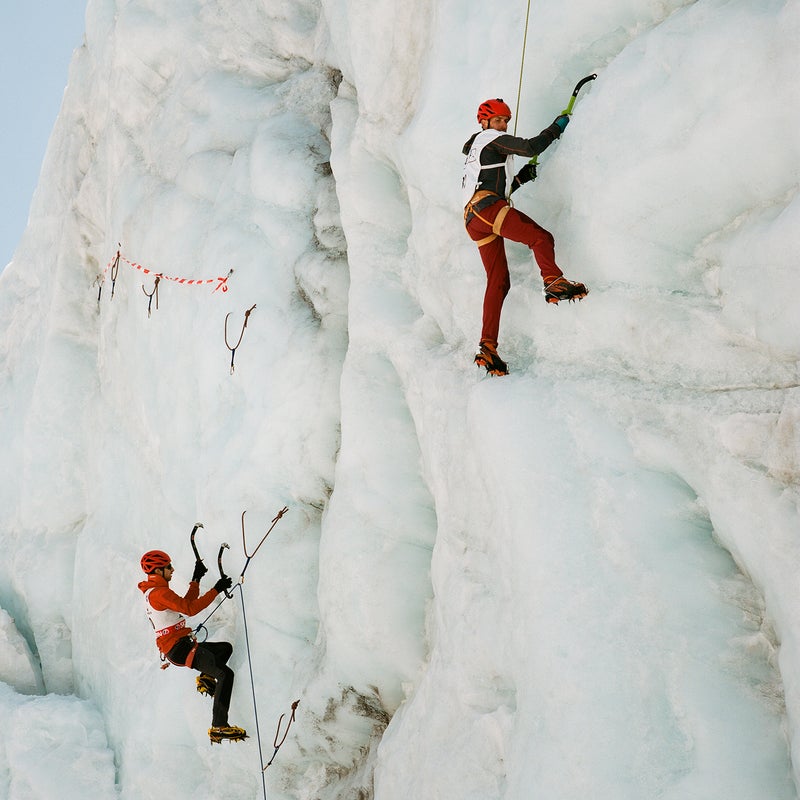
“This is a state exam just like the bac,” the slides warned, referring to the standardized test that French high school students take. “Respect the rules, the timings, the documents.”
The candidates would have to make a ski-mountaineering ascent of 4,757 feet in two hours 25 minutes. Packs had to contain full avalanche-safety kit—probe, shovel, and transceiver—and had to weigh at least 15.4 pounds for men and 11 pounds for women. Anyone who didn’t match or beat the required time was out. Two off-piste ski descents would follow, using lifts to go back up after the first.
In a series of workshops, candidates would be assessed on their technical skiing skill. That element was marked on a scale. Here, too, there was an automatic elimination element. Anyone who fell more than once during the ski descents would immediately be sent home.
The next morning, March 19, dawned clear and cold, the sun reddening the granite faces of the Drus above the Mer de Glace glacier. The night before, Obino, the 20-year-old who was sleeping in his car, had cooked a meal of couscous. He left some out, hoping to eat it in the morning. But by then it had frozen hard. He would do the ski climb, dizzy from hunger, on a breakfast bar.
In Argentière, up the valley, a spring balance hung beneath a tree. The ENSA staff weighed the candidates’ packs. Most, despite the cold, had stripped down to light fleeces under the numbered white bibs used to identify them; some wore headphones. A line of red plastic pegs with the blue and white ENSA logo marked the course they would take: up a piste and into the woods, on steep ground. The trail was narrow, and the candidates departed in pairs at timed intervals.
The instructors took the gondola. Higher up, the ascent path crossed the groomed ski area, and the candidates zigzagged up the ground below the lifts. The instructors made their way to the top using a chairlift and skis, completing a skin ascent across to a shoulder at 8,600 feet. There they waited for the first arrivals in a cold, isolated world very different from the valley below.
The first candidates arrived in under two hours, and Hulya Vassail clocked in at a strong 2:15. Although the time limits were stiff, only a few failed to make it, but a handful dropped out during the ascent.
For the descent, the candidates formed into small groups, each with two instructors. I went down with Tchouky, who I’d sat with during the interrogation the previous afternoon. We cut a traverse line down skier’s left and entered an open powder field.
“Over there, there are rocks,” Tchouky said when he briefed the group. “You go in front of us, onto the sunny hill, then into the couloir.”
The snow was initially forgiving, and the candidates were capable, but not all were top-notch skiers. One person in my group broke a ski or binding—it was unclear which. He frantically asked to borrow mine, but my setup wouldn’t have fit him. He limped off on one ski, eliminated.
The instructors descended first, to be in place as the candidates did their terrain tests. The easier higher slopes gave way below the timberline to defiles lined with tree roots and narrow ravines. The second line, after a swift traverse across the pistes, went down a tall mogul field under a crag, followed by more difficult passages through trees.
Eventually, it was over. “Breathe, relax,” said Christophe Jacquemoud, the guide who had organized the test, as he stood on a snow-covered hump among the brush. “Go back to the piste, descend to the bottom.”
That evening, in a ritual that would be repeated throughout the Probatoire, Marsigny walked wordlessly from his office and pinned up a list of names in the ENSA lobby: 75 who would move on to the next stage. After just two days, the Probatoire’s attrition rate was more than 40 percent.
Before the results were announced, LuÂcien Boucansaud had been confident. “It was super,” he replied when I asked how his day had gone. “We had relatively cold conditions. The snow was good. I think it went OK.” He was right: he got through. Thomas Krommenacker also made it, as did Hulya Vassail and Baptiste Obino. Leo Pfitzner, the boy from OrlĂ©ans with the elaborate journal, was eliminated.
Whether all these theatrics produce good mountain guides is a complex question. It’s hard to compare France’s fatality numbers to other countries, because there are no uniform statistics. In France, any accident that involves injury or damage to equipment has to be logged, but reporting rules are different elsewhere. Still, it’s widely believed, and largely accepted by the French climbing establishment, that French guides have historically suffered more accidents than guides in other alpine countries.
Some attribute this to the complex terrain of the Mont Blanc massif. Christian TrommsÂdorff, a French guide who serves on the international committee of the IFMGA, suggests that the heavily glaciated western Alps present more problems and hazards than, say, the Italian Dolomites.
“The Dolomites are dry, there’s no mixed climbing. It’s rock, it’s quite solid,” he told me. “The level of risk in a hundred days of mountaineering in the Dolomites is fundamentally different from a hundred days here.”
Zoe Hart, the American who teaches at ENSA, also pointed to the local terrain.
“The accidents in French mountain guiding are more elevated, but it’s impossible to compare,” she said. “Imagine you’re a guide in Yosemite, you’re working on a rock climb that’s granite, that’s solid rock, every day. And imagine you’re a guide in Chamonix, and you’re taking a lift to high altitude, to ski on the glacier, in climate change.”
Others aren’t sure about the terrain explanation, pointing out that arguably, the ÂItalian side of Mont Blanc is more topographically complicated than the French side, and yet Italian guides still don’t have the same accident rate as the French. In this analysis, the difference stems from the testosterone-laced French guiding approach, not the slopes above Chamonix.
In my home country, the UK, British climbers often complain about the behavior of French mountain guides. A perusal of online forums reveals many specific beefs, from a French guide “front-pointing up my rucksack” to guides removing slower climbers’ protection so they can move faster.
It isn’t easy to untangle such anecdotes, especially since the British and French have always been rivals. The French counter that we Brits think we’re still in Scotland, where you need lots of extra clothing, and we’re unable to understand that in the Alps, with the objective dangers of rock and serac fall, there’s safety in speed and merit in placing less protection.
However, the notion that French mountain guides take more risks is accepted closer to France, too. Mario Ravello, an Italian guide based in Morgex—on the Italian side of the Mont Blanc massif—describes French guides visiting his region with parties of ski tourers, shooting past at high speeds on avalanche-prone terrain that the Italians ski more conservatively. François Marsigny says that such perceptions about French guides are accurate in some cases but not all, calling them “succinct generalities.” He adds that the French are often more willing than their foreign counterparts to take clients on major routes, such as the north face of the Eiger.
It’s difficult to avoid linking these takes with the way France selects guides. The overwhelming number of applications means that a cut has to happen, yet the way the Probatoire is structured obviously favors tough young athletes. But for the brief and recently introduced statement of purpose at the start, there’s no acknowledgement that candidates are looking to enter a client-facing profession.
The combination of a storied past and a tough entrance exam makes change hard to implement. The official history of the Compagnie des Guides de Chamonix, a hardbound volume with lavish pictures, is clearly intended as a hagiography, with gushing portraits of guides ancient and modern. But reading between the lines reveals a conservative profession that has, in its time, initially opposed almost every new development in two centuries of alpinism, from attempting any but the easiest summit routes to the admission of non–valley natives and women to the ranks of guides.
In recent years, however, some change has been forced on the French guiding community, and the impetus has been death. Among the 62 guides killed in the aughts was Karine Ruby, a native of the Chamonix Valley who won a silver medal in snowboarding at the Salt Lake City Olympics in 2002. She subsequently trained as a guide, and in 2009, still an aspirant, she died, falling into a crevasse on the Glacier du GĂ©ant in the Mont Blanc massif. One of the two climbers roped to her was also killed. Nine other guides died in accidents that year.
In 2011–12, ENSA halted the entire guide-training program for a year to reformulate its syllabus. A new course emerged, with updated modules covering psychological stress and client management and, the administration claims, less focus on sheer alpine performance as the sole measure of guiding competence.
But beyond the addition of the personal statement at the beginning, there was no alteration to the Probatoire. While it’s possible to wash out during the training itself, nowhere near as many do as at the start—therefore, who becomes a French guide is still largely determined on the same narrow grounds of technical proficiency and performance. While the large number of French guides getting killed did lead to a reassessment of how they’re trained, selection of the raw material remains the same. And that funnel rewards aggressive young athletes, not careful client managers.
Four months after the Probatoire’s winter phase, 75 remaining candidates crowded onto a little red train that winds up and down the Chamonix Valley. It was a different world now, the first day of July, with the snow gone, the meadows green, and tourists ambling around town in shorts and sunglasses. The candidates wore a riot of brightly colored French outdoor apparel and trail shoes.Â
The first exercise of the summer Probatoire, an orienteering test, was put together by Elodie Le Comte, one of a handful of women on the school’s staff. Twenty-two orange checkpoints were scattered in a zone of the valley around the Chalets de Charousse, close to the village of Les Houches, about five miles from Chamonix. Each candidate was given one of five separate maps marked with a course of six checkpoints.
“It’s different for everyone,” Le Comte explained. “They have to find all the checkpoints in one hour and 30 minutes—if they miss one, or exceed the time limit, they are eliminated.” The route covered 3.42 miles and 909 feet of ascent. Permitted equipment included compass, map, and altimeter. No GPS.
At the starting line, François Marsigny stood in a baggy blue shirt and shorts, an outfit that looked incongruous on his spare frame, like a tutu on a scarecrow.
The candidates would have to make a ski-mountaineering ascent of 4,757 feet in two hours 25 minutes. Packs had to contain full avalanche-safety kit—probe, shovel, and transceiver—and had to weigh at least 15.4 pounds for men and 11 pounds for women. Anyone who didn’t match or beat the required time was out.
Once again, the candidates set off in a staggered fashion and were soon spread out. The checkpoints were sited clearly, at road junctions or other obvious map points. You were not expected to cut through bush to find them. Here, too, as with the climb during the ski test, attrition was designed to be limited.
“I found it quite easy,” Hulya Vassail said at the end of the exercise. “It’s just simple map reading.” I asked which tests were harder for her. “That’s personal,” she said, then answered: “For me, the climbing is the hardest.”
Krommenacker, who also made it, pointed out another candidate to watch, a young man with light brown hair named Gaël Marty, who had pursued sport climbing to a competition standard before giving that up, though he still worked as an instructor.
“I think 300 days a year to train in the climbing gym, it’s hard,” Marty would tell me later, explaining his change of direction. “I want to ski, climb ice, and not do the same thing every day.”Â
That night, there were 66 names left when Marsigny posted his list. The real winnowing would happen the following day: on the ice.
In the past, when the current generation of senior guides were doing their Probatoires, the ice test took place on the Bossons Glacier, the tumbling expanse of steep ice that falls from the north face of Mont Blanc towards Chamonix. In the eighties, the Bossons reached down to within a few minutes’ walk of the road, but no longer. Climate change has withered the ice fields, and the Bossons has retreated up the hillside. This has left a scrubbed moraine landscape, edged with trees, whose exposed rock and lack of vegetation make it look like land scarred by industry.Â
In response, ENSA moved the exam to the Mer de Glace, France’s longest valley glacier, but it retreated, too, and now the test takes place on the Glacier du Tour, the last bowl before the Swiss border. On the morning of July 2, a Tuesday, candidates gathered at the cable-car station at Le Tour, the roadhead.
After a gondola and chairlift ride, followed by 90 minutes of marching uphill on grassy slopes, the trail contoured up the valley and onto the lateral moraine. There, candidates put on their crampons, almost universally worn over lightweight boots like La Sportiva Trangos, with no lip at the front. They set out for individual stations. Today there were four, located in crevasses on the glacier, overseen by Philippe Batoux, an ENSA guide who was in charge of the ice test.
The test involved various traverses on steep ice that gauged candidates’ skills with crampons and ice axes. When it came time for the four remaining women to make the final climb, Hulya Vassail went first, moving rapidly up the ice. On the traverse, she neatly hooked her axes over her shoulders to swap them as she went left. She easily beat the time limit of six minutes.
MĂ©lanie Martinot struggled. When the six-minute mark arrived, she was toward the end of the route, but she hadn’t done her downclimb. “It’s not great,” she said afterward. “I don’t know what decision they’ll make. But it could be elimination.”Â
Aurélia Lanoë got through with another solid performance, but Valentine Fabre had a tough day and was too slow. “I was
really stressed,” she explained later. “I didn’t have the capability, I couldn’t perform. I’d lost all my confidence, everything.”
That night, when Marsigny emerged with the results, Martinot, Lanoë, and Vassail advanced, while Fabre was eliminated. She wasn’t alone. There were only 50 names left on the list. The ice had taken its toll.
Two days of rock-climbing tests followed the ice day. The first, the mixed-terrain test, would be done in mountaineering boots. The second, on steeper slopes, called for rock shoes. Day one happened above Vallorcine, ten miles up the valley, close to the Swiss border. The candidates’ interpretation of climbing boots that day was pretty light: the same light boots worn on the glacier.
From the car park in Vallorcine, the candidates were ordered to do a stout approach march of 3,773 feet, with two hours to finish. The pack weights were now the same for men and women: 13.2 pounds. Between the two tests, Marsigny had gotten an anonymous letter that bemoaned the perceived double standard.
“Introducing women is a good idea, no doubt,” it said. “But there is an issue with the weight of the packs. … Asking for a different pack for a woman is the same as asking for a lighter pack for someone in a delicate situation.” Marsigny denied that the letter spurred a policy change, saying the decision had already been made.
The path threaded up from the valley floor, rising through the forest and above timberline toward the clustered huts of the Refuge de Loriaz, at 6,627 feet. From there, the candidates hiked to a ridgeline 1,135 feet farther up. Krommenacker, the ex-banker, explained that the long approach, which had a time limit, was designed “to make it difficult to pull off a miracle.” That is, if you’ve just yomped up almost 4,000 feet, you’re not going to climb beyond your usual level.
The ridge was rocky and bare. Candidates pulled on their harnesses and came down to the first climb, where they were watched by the instructors. Three took off at any one time, belayed by their successors, in lanes marked with red and white tape. As with much of the Chamonix Valley, the cliff was bolted for protection, and the required climbing level was roughly equivalent to 5.10a. After the climb, the candidates traversed the ridgeline to the next obstacle, a steep descent. On the crest perched Pierre Gourdin, an ENSA instructor who had worked in British Columbia.
“Do I have time?” a nervous candidate asked him, fussing with his pack.Â
“Yes, yes,” he said. “Calm, calm, breathe, prepare everything. Be calm, this isn’t the assessment. Take the time to go up.”
The next test was a steep crag descent, with candidates judged on speed and style. From there, a fixed rope ran down and into boulder-strewn waste below the ridge, toward the obstacle that, for some, illustrated the insanity of the Probatoire: boulder parcours. In this challenge, candidates are expected to run through a boulder field at high speed. Quickness is a major judging factor.
Guide Caroline George has some doubts about the test. “I can’t remember the last time I had to run through a boulder field with clients,” she says. “So I don’t see how it’s pertinent other than to show that you have good proprioception.”Marsigny insists it’s a valid challenge. “It’s there to assess the agility of the candidate in difficult terrain,” he says. “I don’t have reliable data regarding accidents.”
Up above the Refuge de Loriaz, the candidates pounded around the boulder field. Krommenacker was pleased with his performance; at his age, he knew he had less explosive muscle power than the younger candidates, and he had organized his nutrition carefully for the day, with gels to keep his energy up.
Vassail, after her strong performance on the ice, was worried. She’d fallen on the climb: not an automatic disqualifier, but a bad sign. “That’s a big penalty,” she said. “I’m a bit sad, but above all I’m stressed.”
Afterward, photographer Nicolas Blandin and I walked down with Marsigny and the administrative head of ENSA. At Vallorcine, down by the river, we found Baptiste Obino, the 20-year-old who’d slept in his car in the winter. This time, in better weather, he was living in a tent, which he moved when new venues were announced. His dirtbag creed extended to his footwear, too: his trail shoes were repaired with duct tape. He claimed to be washing in streams.Â
That night, as always, Marsigny emerged with his list. Krommenacker, Marty, and Obino all got through. Among the women, Lanoë and Martinot made it. Vassail was out.
It used to end there. Until 2011, the Probatoire finished after the technical tests, but there’s now a final element: a week in the mountains. After Marsigny finished his briefing on Thursday night, he advised the candidates to rest during the weekend.
On the following Monday afternoon, the remaining candidates—41 had passed the rock test—sat in the upstairs library at ENSA. For the second week in a row, they would separate into groups of three or four, each with an instructor, and scatter across the Mont Blanc massif and farther afield. One group would end up on the Nadelhorn and the other 13,000-foot peaks above Zermatt in Switzerland. It was during this assessment week that a Probatoire candidate was killed in 2018, and Marsigny was reluctant to let journalists go along, given the seriousness of the terrain and our relative inexperience.
But on the last day he gave in. He explained that following the candidate’s death—which took place in a fall above the Argentière glacier—they had changed the system. Now, if you’d passed the technical tests but failed the mountain week, you could return to do that part again, without resitting the first tests. The intention was to reduce the pressure on the candidates, a factor Marsigny believed had contributed to the fatal accident.
That night, when Marsigny emerged with the results, Martinot, Lanoë, and Vassail advanced, while Fabre was eliminated. She wasn’t alone. There were only 50 names left on the list. The ice had taken its toll.
On the final day, a Friday, I traveled up the Brévent cable car with Marsigny and four candidates. Among them was Mélanie Martinot, one of the two women left. She’d had a bad day in the mountains earlier in the week and knew she was on the brink.
The Brévent stops at 8,284 feet, with an extraordinary panorama of the Mont Blanc massif opposite. After disembarking, we walked down the back side of the ridge over patches of old snow, to the foot of the cliffs that form the north face of the peak. Our objective, a bolted route called Poème à Lou, already had climbers on it, so we moved to the next line over, Le Fin de Babylone, which was also bolted. The hardest pitches on the route were rated 5.10c.
The party set off on two ropes, moving elegantly up the smooth granite. Below, large vultures circled on the thermals. Three hours later, the first rope team came over the broken ground beneath the cable-car station. They unclipped, packed up their gear, and took the first cable car down.
When we got back to ENSA, waiting for the final cut began. It was late afternoon when Marsigny emerged with the sheet. In all, 45 people had passed. Krommenacker, the ex-investment banker, got through. So did Baptiste Obino, the dirtbag, and Lucien Boucansaud, whose father had died when he was 18. I asked him what his dad would think.Â
“He’d say he was happy for me,” he said. “I’d say thank you—for all that he gave me.”
Mélanie Martinot didn’t pass; following her wobble the previous day, she was eliminated at the last hurdle. In the hall, standing by the list, she looked utterly devastated. I asked if she would try the exam again. “I don’t know,” she said.
The one woman who passed was AurĂ©lia LanoĂ«, the van dweller. I asked how she felt it would be to train as the lone woman with all the men for the remainder of the three years of the program.Â
“The fact that I’m the only woman, it’s not a big deal,” she said. “I’d have preferred if there were some other women, but I can handle it as it is.”
I asked how she thought the training, due to start in September, would go.
Her reply was all business: “I’ll tell you next year.”
Simon Akam () wrote about Scottish backcountry skiing in November 2017.



